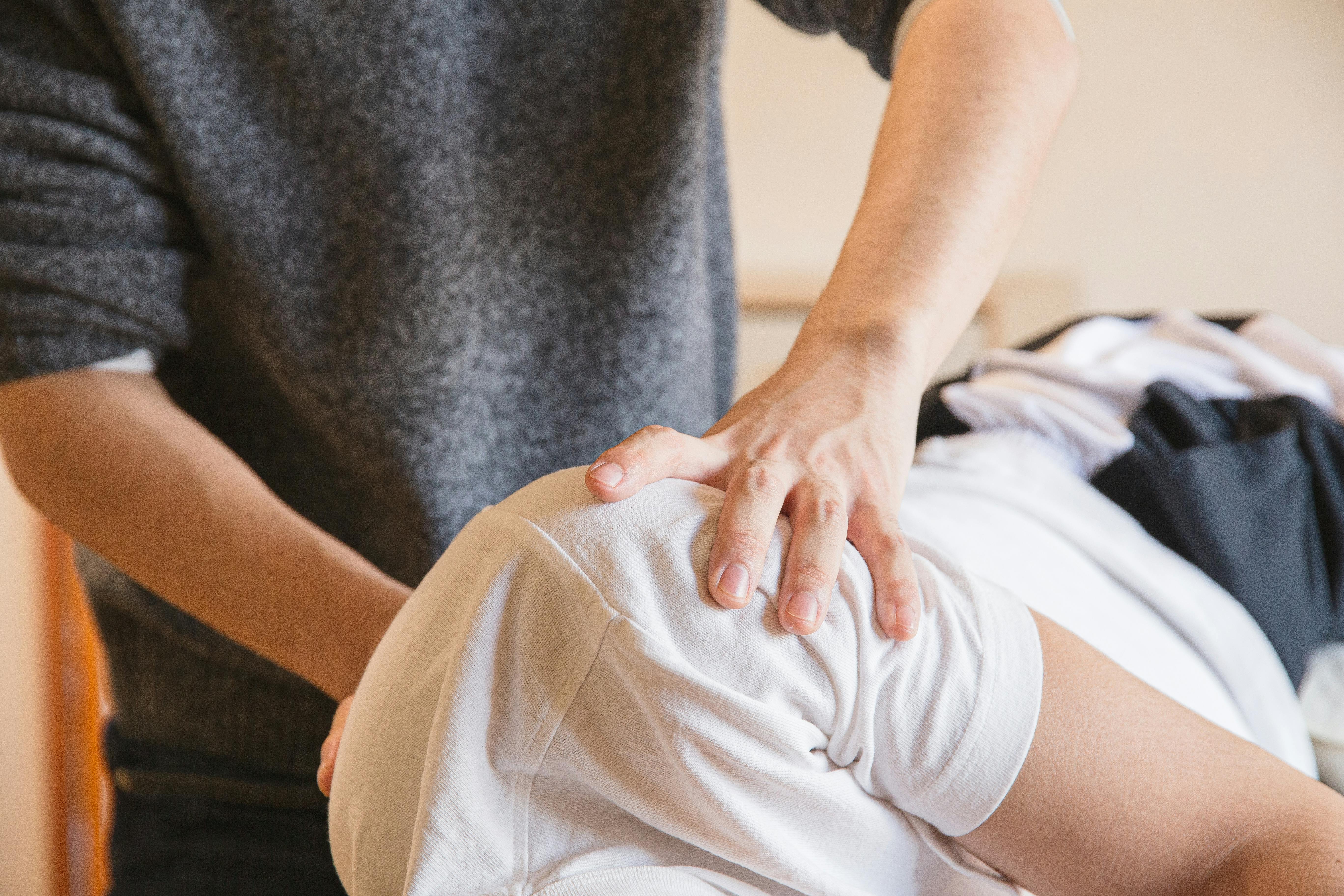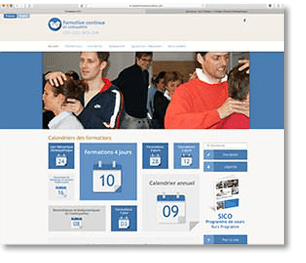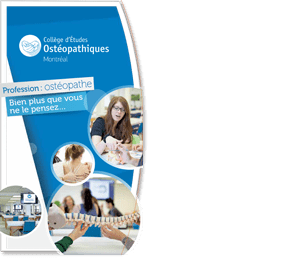550,
Ave
Beaumont,
suite
500
Montreal,
Quebec
H3N
1V1

Tradition, Clinical Methodology, Research and Know-How
Definition of osteopathy
In
1874,
Dr.
Andrew
T.
Still
defined
osteopathy
as
natural
medicine.
He
used
the
quality
of
his
palpation
to
assess
and
treat
his
patients.
The
originality
of
his
practice
lay
in
the
fact
that
he
focused
on
restoring
health
rather
than
merely
combating
the
symptoms
of
the
disease.
The
therapeutic
aim
of
osteopathy
is
to
restore
movement
and
function
to
the
mechanisms
that
keep
the
body
healthy.
To
achieve
this,
it
is
important
to
assess
and
treat
the
causes
of
symptoms,
pain
and
dysfunction.
Osteopathy
is
a
science,
an
art
of
palpation
and
a
rigorous
clinical
methodology
based
on
precise
palpation
aimed
at
freeing
the
body's
various
tissues
from
their
restrictions,
blockages
and
compressions
to
perform
their
natural
functions.
The
aim
of
professional
osteopathy
is
to
restore
movement
to
the
body's
structures
and
functions
(bones,
joints,
ligaments,
muscles,
tendons,
organs,
viscera,
cranial
sutures,
etc.).
Among
other
things,
this
improves
blood
and
lymph
circulation
and
promotes
metabolic
exchange
between
all
the
body's
systems,
nerve
function
and
vascularization
of
the
digestive,
pulmonary,
cardiac,
reproductive,
elimination,
cerebral
dynamics
and
many
other
body
functions.
To
achieve
this,
the
patient
is
always
treated
as
a
whole.
The
concepts
and
principles
enunciated
by
Andrew
T.
Still
are
still
alive
and
well
and
can
be
applied
to
the
development
of
clinical
methodology.
These
principles
form
the
basis
of
our
teaching.
The Origins of Osteopathy
It
was
in
the
United
States
in
the
19th
century,
that
the
original
principles,
concepts
and
methods
of
osteopathic
assessment
and
manual
care
were
developed
by
Dr.
Andrew
T.
Still.
Still.
Born
in
Virginia
in
1828,
he
studied
medicine
in
Kansas
City,
where
he
acquired
an
excellent
knowledge
of
anatomy
and
physiology.
With
an
inquisitive
and
rational
mind,
he
quickly
established
relationships
between
structural
disorder,
functional
disorder
and
disease.
Devoted
to
his
patients,
Dr.
Still
was
devastated
in
1864
by
the
loss
of
his
wife,
three
of
his
children
and
many
of
his
patients
to
a
meningitis
epidemic.
This
event
was
decisive
in
his
realization
of
the
limitations
of
conventional
medicine
and
drugs.
He
then
stopped
practicing
to
study
and
seek
other
ways
of
relieving
his
patients
more
effectively.
During
the
Civil
War,
his
experience
as
a
physician
and
anatomist
enabled
him
to
perform
reconstructive
surgery.
After
10
years
of
research,
he
returned
to
his
patients
with
a
new
way
of
looking
at
care,
which
led
him
to
officially
create,
on
June
22,
1874,
the
term
"osteopathy"
based
on
concepts
and
principles
that
are
still
relevant
today
and
represent
the
foundations
of
traditional
manual
osteopathy.
By
this
time,
Dr.
Still
had
come
to
understand
that
the
key
to
health
lies
in
the
balance
of
the
skeletal
framework,
which
is
responsible
for
the
harmony
of
the
nervous,
muscular,
facial
and
circulatory
systems.
He
also
recognized
that
the
health
of
the
organs
and
the
musculoskeletal
system
were
interrelated
and
interactive.
He
even
postulated
that
"structure
governs
function".
From
this
postulate,
he
eventually
put
forward
the
main
principles
underpinning
osteopathic
clinical
methodology
and
therapeutic
specificity.
They
can
be
summed
up
as
follows:
- Structure and function are linked;
- The body is a functional unit;
- The role of the artery is absolute;
- The body has its own capacity for self-regulation, defense and recovery.
In 1892, Dr. Still founded The American School of Osteopathy, the first school of osteopathy in Kirksville, Missouri, which is now a university, the Kirksville College of Osteopathic Medicine. This teaching soon became very popular, and Dr. Still was fortunate enough to teach over 5,000 students in his lifetime.
In 1917, Osteopathy took root in Europe thanks to Dr. John Martin Littlejohn, D.O., a student of Dr. Still. He founded the British School of Osteopathy, the first school of osteopathy in England. The European School of Osteopathy in Maidstone and other institutions have enabled English osteopathy to occupy an important place in the English healthcare system. Today, the major schools are affiliated with universities.
In France, traces have been found of a school and a French-language book written in 1913. Dr. Major Stirling, D.O., settled in France and taught a group of doctors. Osteopathy really took off in the 1960s. The first course in Osteopathy applied to the cranial sphere was given in Paris in 1965, with Thomas Schooley, D.O., Harold I. Magoun, D.O., and Viola M. Frymann, D.O., all students of William Garner Sutherland, D.O.
Two famous French osteopaths were present: Francis Peyralade, D.O., and Bernard Barillon, D.O. The first French colleges were the roots of other institutions in Belgium, Spain, Italy, Portugal, Switzerland and Germany. French osteopathy is highly respected and is expressed primarily in the evolution of this medicine in the visceral sphere with Jean-Pierre Barral, D.O., Jacques Weischenk, D.O., René Briend, D.O.
In the United States, Osteopathy evolved over the years towards the practice of medicine and surgery, abandoning traditional Osteopathy based on palpation and manual therapeutic methods. However, the American Academy of Osteopathy has made every effort to preserve Osteopathy's original philosophy and potential. Osteopathic medicine is currently taught at 15 universities in the United States.
On June 16, 2022, the Office des Professions du Québec published its favorable opinion on creating a professional order. To find out more about the advances made in the regulation of the profession in Quebec, please visit the Osteopathy Quebec Association page: www.osteopathiequebec.ca/fr/encadrement-de-la-profession-osteopathes..
How can I become an osteopath in Canada?
We offer a 5-year part-time training program for healthcare professionals at our campuses in Montreal, Vancouver, Halifax and Winnipeg.We also offer 5 years of full-time training for college graduates, health professionals wishing to retake basic health sciences or people in career transition. This training is available at our Montreal college only. For more information on our programs :
www.collegeosteo.com/montreal/Programmes
www.collegeosteo.com/quebec/Programmes/
www.collegeosteo.com/vancouver/Our_Program/Program/
www.collegeosteo.com/halifax/Our_Program/Program/
www.collegeosteo.com/winnipeg/Our_Program/Program/
Please note that our colleges in Canada allow you to obtain a D.O.M.P. or a D.O. If you would like to understand these terms better,click here.
Osteopathic associations and organizations in Canada
There is, as yet, no osteopathic association in Canada. To practice, osteopaths must be accepted by an osteopathic association. All associations in Canada accept our diplomas.A non-exhaustive list of associations in Canada:
Osteopathy Quebec: www.osteopathiequebec.ca
OAO Ontario: www.osteopathyontario.org
NSAO: www.novascotiaosteopaths.ca
MAOMT: www.osteopathymanitoba.org
Osteopathy BC: www.osteopathybc.ca
Contact Us
550,
Ave
Beaumont,
suite
500
Montreal,
Quebec
H3N
1V1
Tel.:
(514)
342-2816
Tel.:
514-342-2816
Fax:
(514)
731-7214
[email protected]




